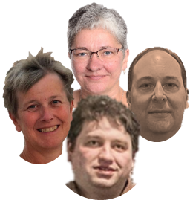Eld Zierau, Jette Junge, Claus Jensen and Lars Lundegård Olsen form the specialist group for digital preservation at the Royal Danish Library
There is a growing tendency in libraries and archives to strive for standard solutions, and a conception that all digital preservation challenges can be solved by one product. Our claim is that trying to achieve this constitutes one of the biggest risks for all types of materials.
The merger of two national libraries with the same goals and under the same jurisdiction has revealed how much the devil is in the detail and how the thought of “One Size Fits All” is indeed questionable within digital preservation as for many other areas. As it turned out to be so hard on a national level, it is surely much harder at an international level where there are legal and cultural differences.
Of course merging libraries is a question of aligning efforts, and the library management had therefore also expressed a vision of handling all digital preservation by one specific system. The challenge is that the suggested system was chosen based on considerations of the specific materials handled by one of the two merging libraries, and later analysis showed that this system did not fit in with the materials from the other library.
After numerous tenders for digital preservation systems, we are convinced that at present no systems exist which by itself can cover all aspects of proper digital preservation. The insufficiencies are different and in different areas like
- missing modularity for complex materials
- missing possibilities for proper bit preservation
- missing possibilities for preservation of metadata
- missing possibilities for making various digital curation processes in preparation of digital preserved data
- missing possibilities for making various digital curation processes in maintenance of digital preserved data
- …
The big challenge for digital preservation specialists and the community is to convince the management layer of the need to spend many more resources on digital preservation besides licences for digital preservation systems. Not only for operations, but also for handling aspects not covered by “standard solutions”. This involves research, development, community involvement and collaboration with other organisations.
In the library merger, it took more than a year’s hard work and involved many employees at all levels of the organisation to establish common Digital Preservation Policies and Strategies. The higher-level policies were not that hard, but the detailed strategies posed big challenges, since this was where the detailed challenges for different types of materials appeared.
We have come a long way, which is partly expressed in the iPRES 2019 paper “Preservation of Metadata”. However; we have still not solved all challenges. An example is the alignment of material identifiers; one of the former libraries used inherited metadata in the naming convention for identifiers used as file names in order to facilitate operations on large amounts of data, even though metadata sometimes change. The other library used UUIDs to avoid misinterpretation by having metadata in the identifiers.
We have managed to address issues regarding research, skills evolvement, community involvement and collaboration with other organisations, even though there were different traditions in the two former organisations, - now we just need to ensure that this is carried out in practice.
There is no doubt that we need to find the similarities which can form “standard” solutions, but as a community we also need to remember that there is a risk of loss if we “forget” the differences and convince ourselves about one size fits all. We need each other as collaboration partners and as a community to overcome the challenges within the details.
